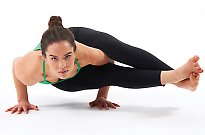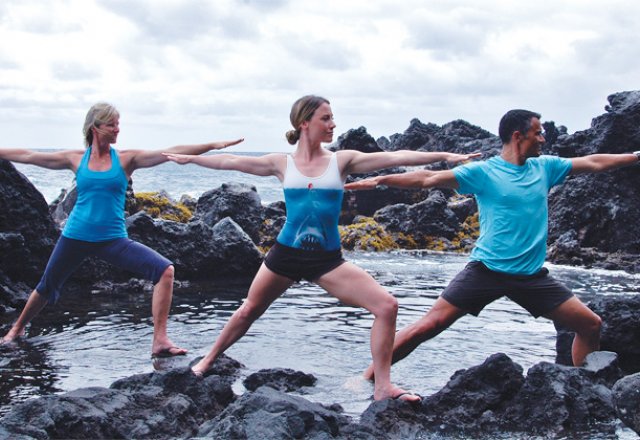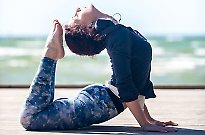
Ohana Yoga

A new hybrid of restorative yoga
Liz Nowosad meets up with Gena Kenny to discuss the benefits of Ohana Yoga.
I met Gena Kenny – yoga instructor and author of the best- selling Gift of Yoga book and DVD in a café near her Bridport Street studio in Albert Park, Melbourne. Within seconds of meeting, she handed over a class timetable and her dog Duke’s business card, which I suspect is actually hers, unless her dog shares her mobile phone.
Gena has the inner light and open heart of a true yogi and is incredibly passionate about teaching and practising yoga. She has a great sense of humour and genuinely cares about the happiness and wellbeing of her students. It’s no wonder her studio, Ohana Yoga, is going from strength to strength and her Hawaiian yoga retreat is such a hit.
What led you to yoga?
I started practising yoga to heal from an injury I sustained as a firefighter. I always remember the struggle I initially had with the relaxation part at the end of a class…being still and quiet was quite new to me! Then yoga became something I did for myself to find balance. It helped me on a very deep level and taught me so much about myself as a person. It wasn’t long before I realised how much I needed it in my life. I was going through a difficult break up from a marriage that didn’t honour me, and it really helped me through. I went back to firefighting when I healed from the injury but continued regular yoga practice.
Where and in what type of yoga did you train as an instructor?
I had been practising yoga for two years and knew I wanted to help others as I had gotten so much enrichment from it myself, so I studied for four years and then I started teaching. I trained in Hatha yoga in Geelong, in a very traditional, ancient way, involving four years of one-on-one personal instruction. I feel very grateful for the depth of teaching I received. Hatha yoga is all about balance. ‘Ha’ means sun and ‘tha’ means moon. In Hatha, you generally hold the postures for longer and you learn how to breathe deeply, learning how to create movement from the inside out rather than trying to force the movement.
When did you become a full-time instructor?
I retired from the fire brigade five years ago, but the retirement wasn’t my choice. I injured myself a second time – more seriously this time, and the injury meant I couldn’t go back to firefighting. I was already teaching yoga at that point – I’ve been teaching yoga for about 17 years – but back then, yoga was my hobby and firefighting was my full-time job.
The injury led me to study yoga for spinal care and also restorative yoga. On reflection, I feel the injury was a gift that set me on this journey.
You’ve developed your own style of restorative yoga at your studio, Ohana Yoga. Tell us a little about that.
The style that I was originally taught in was Hatha, and I also studied the energy body and ways to help the energy body, which is actually done a lot in Kundalini yoga. So basically what I did was to take the study of the Hatha yoga and the study of the energy body and also the study of spinal care health and weaved it all in.
So you came up with very healing poses in a very calming environment?
Yes, and also movements that teach students how to reconnect with how their body moves, which ties in a little with Feldenkrais (Feldenkrais Method facilitates learning through lessons that explore movement, posture and breathing) – which we also teach at the studio. There is also something that innately comes to me when I teach. I don’t have a ‘plan’. I arrive and I have a poem or theme for the day. For example, our theme today is ‘knowing the power of your words’. Often the way we talk to ourselves is how we talk to others. So reflecting on how you talk to yourself, what that inner language is, can be valuable when looking at your interactions and relationships with those around you. For example, if you are very critical of yourself, you are likely to be very critical of others.
So we looked at that today at the beginning of class, but I didn’t actually plan the format, as I prefer to sense what the people in the room need. Depending on their physical state and mood, where they’re at that day. Do they need to relax and be calm, or do they need to be energised?
What are the benefits of restorative yoga and can anyone do it?
Restorative yoga is accessible for everyone. The main benefits are to teach your body how to be more in the calm state of its nervous system, and to nourish the organs, the glands and all the systems. If you can imagine, most of us are in fight or flight syndrome a lot of the time, which means the adrenal glands are getting charged up and pushing chemicals out into the body, so the body is ready to run – fight or flight – but it’s not needing to, because no one is actually being chased by a lion! And so what happens is that all of the blood flow and chemicals go into the muscles and they get hard, but inside, the organs and the glands and the systems aren’t getting the nerve supply or the blood supply they need. So while our outer body gets more and more stiff, the inner body gets more and more depleted. So the aim of restorative yoga is to bring back balance. The organs and systems get replenished and nourished and the body and the brain learn how to be more in the calm state of the nervous system.
It does little good to say to someone that is wired up and on the go all the time, “Hey, just relax!”, because they don’t know how. Their brain doesn’t know how. And so restorative yoga teaches people how to deeply relax. Their mind and brain can actually see what relaxation feels like. So they have a gauge, a benchmark. Once they have this gauge, if they go too far to the other extreme, they know how to come back.
Have you had any challenges in setting up the studio?
I think the biggest challenge is having the courage to jump in. You have to be wholehearted with any business and it can be scary. But once you jump in wholeheartedly and you know it’s the right thing, it works.
You have to really believe and have faith that what you are doing is the right thing.
Have you seen a lot of changes in your long-term students?
Absolutely, and not just physical improvements or improvements to their positivity and state of mind. ‘Ohana’ means family and community in Hawaiian, and one of the things that really makes our studio special is that sense of community, which I fully encourage. After class, we go for coffee together, and I see people forming really strong friendships. They are helping each other in times of need, being there for each other. So they meet through yoga and go on to give each other this beautiful support in all aspects of their lives. It’s very special. One lady recently separated from her husband and the people from class helped her move house, made her soups and casseroles, babysat for her so she could get out of the house. It’s beautiful.
You also run retreats in Hawaii. Why Hawaii?
Hawaii is my spiritual home and I feel very connected to the land and the people. People often say they go to Hawaii to feel ‘aloha’. Although aloha is said as a hello or a goodbye, it actually means ‘unconditional love’. And it means unconditional love for everything – for others, for the sun, the moon, the trees, the animals – and when you go to Hawaii, you feel that love.
The environment is a setting in which people can really connect with the essence of themselves and the energy there encourages people to let go of what they think is their reality and move into what is their reality – the essence of who they are. And it invites playfulness, exploration and letting go of barriers. NH
To learn more about Gena’s studio, Ohana Yoga and the Hawaiian retreat, go to www.ohanayoga.com


